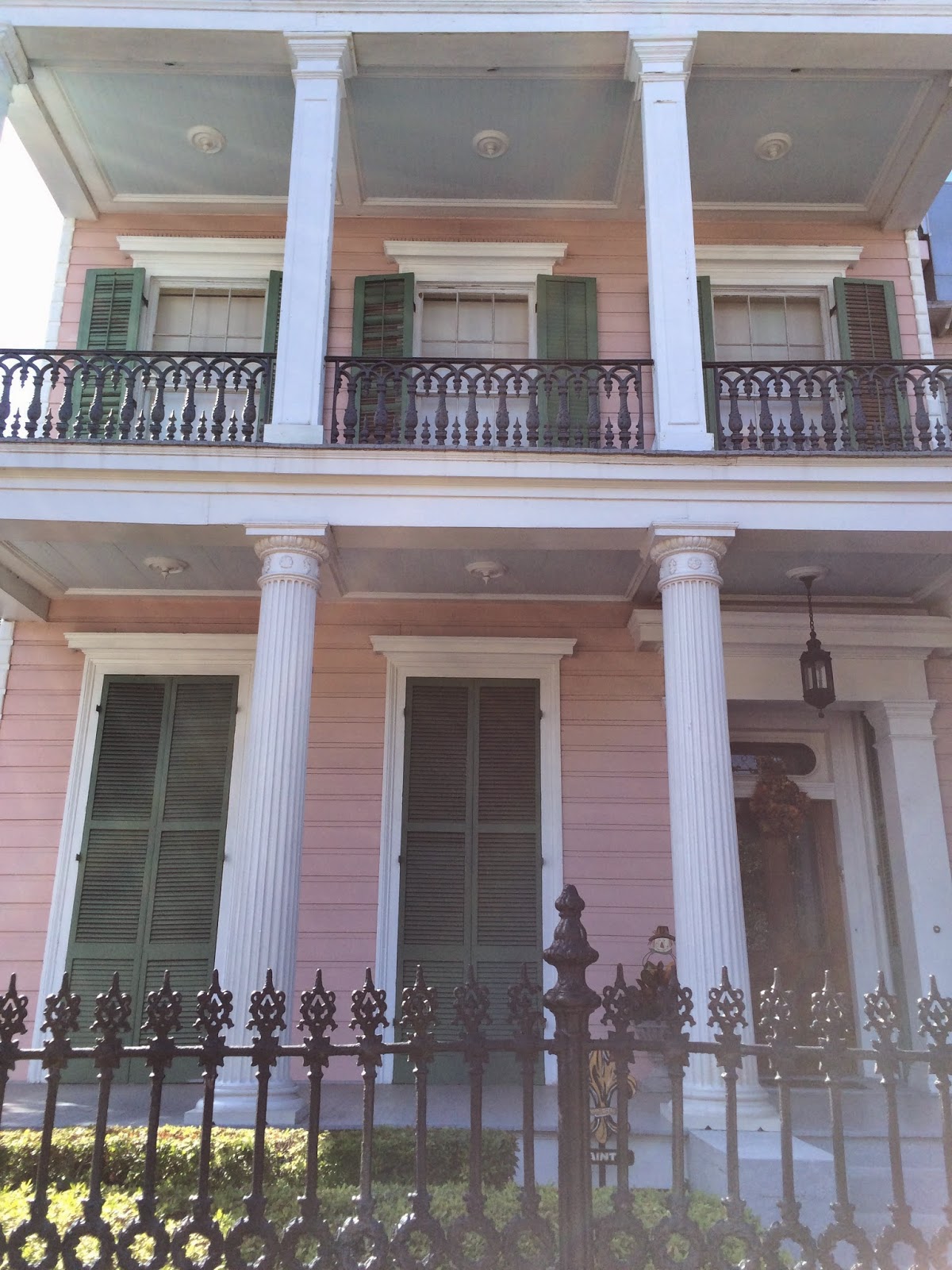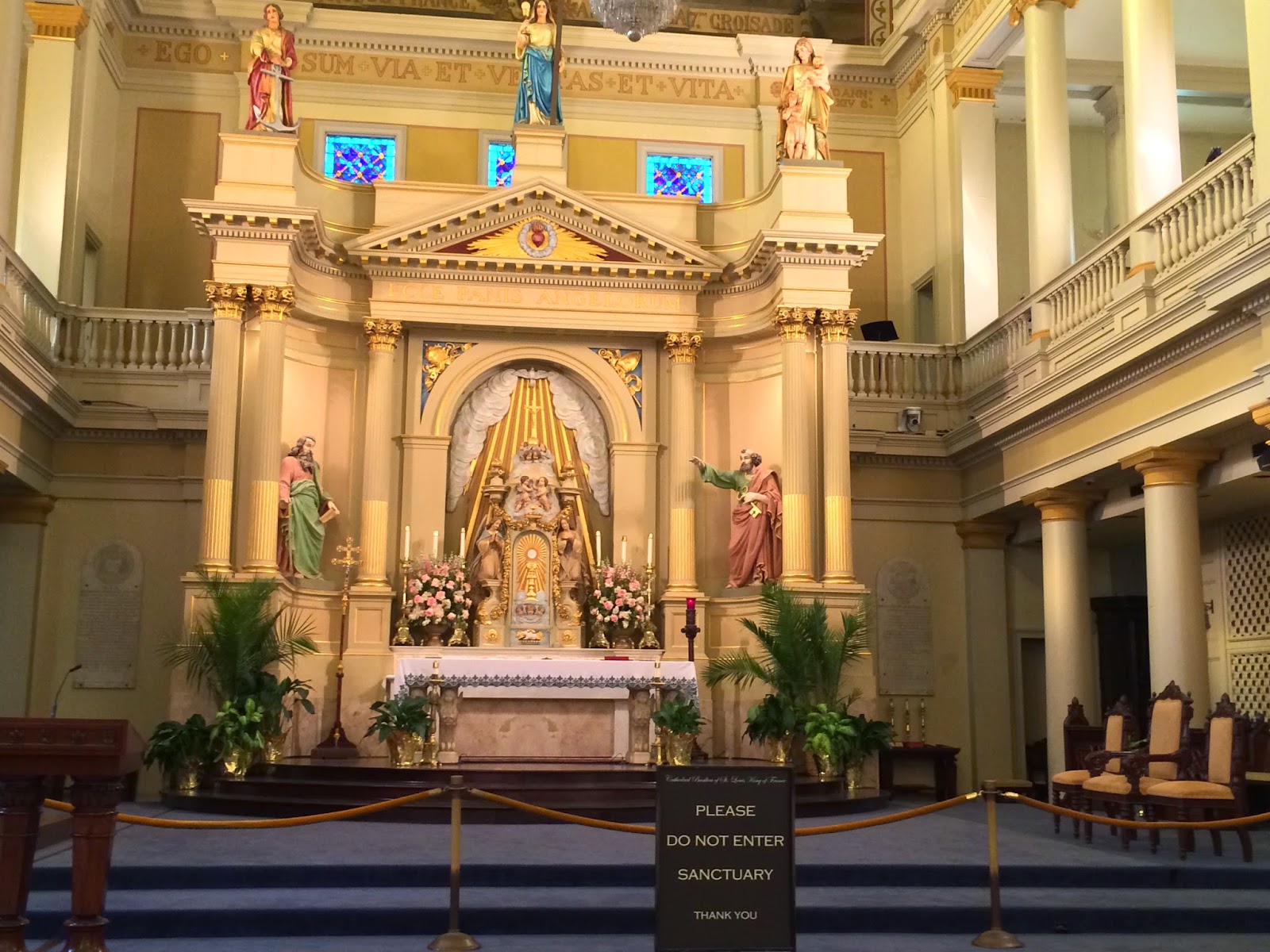Miss Lillian was our first bus tour commentator. I'm always amazed at how well these commentators know their cities.
We got on the bus at 11:15 at stop #5 and by 12 noon we had reached stop #11 where we got off to go on the Garden District walking tour.
We were told a lot by our tour leader but I only remember a few details well enough to comment on them. This is the Goldsmith-Godchaux House, designed by noted 19th century architect Henry Howard in 1859. Howard and James Gallier were the two architects that designed many of the historic houses in the Garden District. Howard is also noted for his use of decorative iron work.
This house, for some reason, retained the markings that were used during Hurricane Katrina to identify the condition the house.
The Garden District was built mainly by the "Americans", as opposed to the French or the Spanish, both of whom occupied this city before the Americans came in 1803. This Church is the oldest Protestant Church in the Garden District and the City.
This picture shows the lovely live oak trees and their low hanging branches. These trees grow throughout the Garden District. One of the reasons why there are so many of these lovely homes still in existence is that New Orleans was not burned during the Civil War, as so many other cites in the South were.
This is the largest "City" house in the Garden District. If you travel out St. Charles Ave., you come to the plantations which are a good deal larger. Perhaps we'll do that tomorrow. At any rate, this house is 20,000 square feet.
Lovely house.
Now this house is special and I took this picture especially for Jacob. It is the home of Archie Manning and the house where Peyton and Eli grew up.
This is the house where Jefferson Davis, President of the Confederacy, died. He was visiting his friend, who owned the house, at the time of his passing.
This is our tour guide Philip. He lives on Philip Street in the Garden District.
Back on the bus, traveling through the business district, we went by the 7 block long Mardi Gras World, a warehouse like building where floats are built, notably for the New Orleans Mardi Gras, but for parades in other cities as well.
We arrived in the French Quarter in time for the 2pm walking tour. The tour began at the edge of the Mississippi River.
This is our tour guide for the French Quarter, Tim, talking about the history of the city.
New Orleans exists because of the Mississippi River transporting eroded soil and depositing it at the mouth of the river on the Gulf of Mexico. That process continues today.
A paddle-wheel boat taking tourists up the river.
We were standing on the levies which are 35 feet high and protect the city. The closer you are to the river, the higher the ground.
Along the street in theFrench Quarter.
This is where Tennessee Williams once lived. At one time there were 269 miles of streetcar lines in the city. One, called the Desire Line, ran through the French Quarter to Desire Street. One night Williams had an encounter with the driver of a car and made a note to call about the driver in the morning. He wrote the name of the car on a manuscript he was working on, and the next day liked the sound of it - a Streetcar Named Desire. That is a woman dressed in feathers standing in front of the house. You can see almost anything in New Orleans.
Bourbon Street is closed to traffic during the day.
There are wonderful carriageways off the main streets that used to house the stables but are now shopping areas.
Tim talking about the buildings, 60% of which remain residential but in the Parisian style, with shops on the first floor and living spaces on the floors above.
Lovely fountain in a carriageway.
This is called Napoleon's House. A former Mayor of the City, Nicolas Girod, lived here. He was an admirer of Napoleon and when he heard that Napoleon was imprisoned on the Island of St. Helena tried to raise an army to go rescue him. He said that he would give Napoleon his house to live in.
The shop of the first licensed pharmacists in the U.S., Louis Joseph Dufilho, and now a Pharmacy Museum.
The St. Louis Cathedral-Basilica is the oldest Catholic Cathedral in the United States. The present church, built and enlarged over the original Spanish foundations (1727) was completed 1851.
The Cathedral is on the edge of Jackson Square. All around Jackson Square are all manner of entertainment. These young men are street musicians playing really good jazz. The tuba added a lot to the music.
Interior of the Cathedral-Basilica. On the right side, the flags represent the countries that New Orleans has been under from its founding to the present. On the left side are the Papal flag, the Coat of Arms of the Basilica and the Coats of Arms of the Dioceses of the Metropolitan area.
The front fresco is of King Louis IX calling the 7th Crusade.
Nice Joan of Arc at the back of the Cathedral-Basilica.
Statue of Andrew Jackson in the center of Jackson Square. There is an identical monument in Columbus Square across from the White House in Washington D.C.
Along one side of Jackson Square, the center of the French Quarter, is a long line of mule powered carriages for hire.
A living statue along Decatur Street. There were a number of these living statues - some in silver and others in gold.
This is not a living statue but a statue of Joan of Arc that was a gift from France.


































Gorgeous architecture!
ReplyDelete